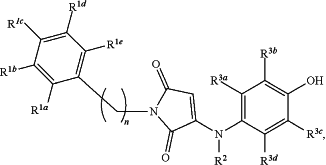| CPC C07D 207/416 (2013.01) [C07D 405/04 (2013.01); C07D 417/10 (2013.01)] | 20 Claims |
|
1. A compound having a structure represented by a formula:
 wherein n is 0, 1, or 2;
wherein each of R1a, R1b, R1c, R1d, and R1e is independently selected from hydrogen, halogen, —CN, —NH2, —OH, —NO2, C1-C4 alkyl, C2-C4 alkenyl, C1-C4 haloalkyl, C1-C4 cyanoalkyl, C1-C4 hydroxyalkyl, C1-C4 haloalkoxy, C1-C4 alkoxy, C1-C4 alkylamino, (C1-C4)(C1-C4) dialkylamino, C1-C4 aminoalkyl, —C(O)R10, —CO2R11, Cy1, and —OCy1;
wherein R10, when present, is selected from hydrogen, —NH2, C1-C4 alkyl, C1-C4 haloalkyl, C1-C4 alkylamino, (C1-C4)(C1-C4) dialkylamino, and C1-C4 aminoalkyl;
wherein R11, when present, is selected from hydrogen and C1-C4 alkyl; and
wherein Cy1 is selected from C6 aryl, C2-C5 heteroaryl, C3-C6 cycloalkyl, and C2-C5 heterocycloalkyl, and is substituted with 0, 1, 2, or 3 groups independently selected from halogen, —CN, —NH2, —OH, —NO2, C1-C4 alkyl, C2-C4 alkenyl, C1-C4 haloalkyl, C1-C4 cyanoalkyl, C1-C4 hydroxyalkyl, C1-C4 haloalkoxy, C1-C4 alkoxy, C1-C4 alkylamino, (C1-C4)(C1-C4) dialkylamino, and C1-C4 aminoalkyl;
or wherein two adjoining R1a, R1b, R1c, R1d, and R1e groups are covalently bonded and, together with the intermediate atoms, comprise a 5- or 6-membered cycloalkyl, a 5- or 6-membered heterocycloalkyl, a 6-membered aryl, or a 5- or 6-membered heteroaryl, and is substituted with 0, 1, 2, or 3 groups independently selected from halogen, CN, —NH2, —OH, —NO2, C1-C4 alkyl, C2-C4 alkenyl, C1-C4 haloalkyl, C1-C4 cyanoalkyl, C1-C4 hydroxyalkyl, C1-C4 haloalkoxy, C1-C4 alkoxy, C1-C4 alkylamino, (C1-C4)(C1-C4) dialkylamino, and C1-C4 aminoalkyl;
wherein R2 is selected from hydrogen and C1-C4 alkyl; and
wherein each of R3a, R3b, R3c, and R3d is independently selected from hydrogen, halogen, —CN, —NH2, —OH, —NO2, C1-C4 alkyl, C2-C4 alkenyl, C1-C4 haloalkyl, C1-C4 cyanoalkyl, C1-C4 hydroxyalkyl, C1-C4 haloalkoxy, C1-C4 alkoxy, C1-C4 alkylamino, (C1-C4)(C1-C4) dialkylamino, and C1-C4 aminoalkyl,
provided that when one or two of R1a, R1b, R1c, R1d, and R1e is —OH or C1-C4 alkoxy and the remaining R1a, R1b, R1c, R1d, and R1e groups are hydrogen, then at least two of R3a, R3b, R3c, and R3d are non-hydrogen groups,
provided that when one or two of R1a, R1b, R1c, R1d, and R1e is —OH or C1-C4 alkoxy and at least one of the remaining R1a, R1b, R1c, R1d, and R1e groups is a different non-hydrogen group, then at least one of R3a, R3b, R3c, and R3d are non-hydrogen groups, and
provided that when one of R1a, R1b, R1c, R1d, and R1e is C1-C4 hydroxyalkyl, then at least one of R1a, R1b, R1c, R1d, R1e, R3a, R3b, R3c, and R3d is a non-hydrogen group,
or a pharmaceutically acceptable salt thereof.
|